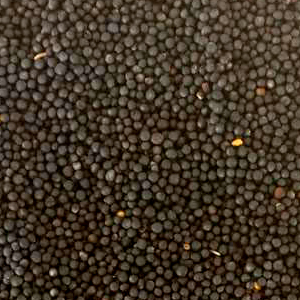What is the difference between canola and rapeseed oil?
Many people confuse or even don’t know the difference between canola, rapeseed oil, and industrial rapeseed oil. All of these varieties belong to the Brassicaceae family and the species Brassica napus. They are closely related to mustard, broccoli, cabbage, and beets. The seeds and plants of the individual rapeseed varieties are almost identical and cannot be distinguished with the naked eye.
The most important difference lies in the erucic acid and glucosinolate content. Both are substances that are toxic to animals and humans. Rapeseeds have an erucic acid content of 45% and a high glucosinolate content. Industrial rapeseed oil is obtained from these seeds, which is used as a biofuel, plastic, and biolubricant with high temperature resistance. In contrast to industrial rapeseed, a rapeseed variety has been bred that has less than 2% erucic acid (double-low varieties or edible oil plants) and a low content of glucosinolates (less than 30 µmol/g in the flour fraction) (canola, 0-rapeseed, or 00-rapeseed). These rapeseed varieties are completely safe for human consumption, and flour from these varieties can also be used as high-quality, high-protein animal feed.
The History of Rapeseed
Rapeseed originated about 7,500 years ago from a natural cross between turnip rape (B. rapa) and kale (B. oleracea) and quickly became an interesting crop grown in many parts of the world. The name “canola” or 00-rapeseed was introduced by the Western Canadian Oilseed Crushers in 1978. Today, canola is a highly profitable crop grown in over 66 countries worldwide. The largest producer is Canada, with 19 million tons in 2019, followed by China, India, France, and Ukraine. The commercially available canola varieties can be divided into two types: the Argentinian type and the Polish type. The difference is that the Argentinian type was developed from the Brassica napus species, while the Polish type was developed from Brassica campestris.
Uses of Canola
Canola can be used for:
- Oil production
- Human consumption
- Rapeseeds contain 35-45% oil, which is one of the reasons why rapeseed is the second most widely cultivated crop in the world after soybeans (18% oil content) (4,5). Modern varieties also contain high levels of polyunsaturated fatty acids (oleic, linoleic, and linolenic) and vitamins (E & K). The resulting oil is considered very healthy and, thanks to its mild flavor and heat resistance, is the most widely used plant-based oil for culinary purposes (frying, salads, dressings, cooking, and baking).
- As animal feed
- Another major benefit of rapeseed is its use as annual animal feed. The high protein content (23-33%) of rapeseed exceeds that of soybean meal (10-20%), which is commonly used as animal feed (cattle and poultry), and could replace it in the future (6). Furthermore, rapeseed can be used directly as a pasture crop, yielding up to 1-2 tons of dry matter per acre per year.
- As the final crop in a planting sequence
- Another unique characteristic of rapeseed is its deep taproot system, which can help reverse soil compaction to some extent. Rapeseed is typically sown before or after winter and spring cereals such as wheat and maize, often followed by a soybean double crop (7). The benefits of rapeseed rotation for wheat yield include an increase of up to 19% and higher quality, which is recognized by both scientists and farmers. Furthermore, rapeseed helps control pathogens (e.g., the pigeon tortrix moth – Gaeumannomyces graminis) (8). Furthermore, along with almond trees, it is one of the first crops to flower in spring and is therefore an important food source for pollinators (e.g., honeybees).
Canola oil is essentially nothing more than cooking oil made from rapeseed. The name “canola” was adopted from American usage as a term for “double-zero rapeseed.” These rapeseed varieties contain no harmful erucic acid or glucosinolates and are therefore suitable for human consumption. The winter rapeseed grown in Germany today is such a double-zero or canola rapeseed.
Rapeseed oil contains many monounsaturated fatty acids such as oleic acid, but also around 30% polyunsaturated essential fatty acids such as linoleic acid (omega 6) and linolenic acid (omega 3), making it particularly valuable for nutrition. In America, canola oil, for example, is therefore declared to be particularly “heart-healthy.” Furthermore, cold-pressed rapeseed oil, in particular, contains vitamins and carotenoids.
Rapeseed oil, for example, is considered at least nutritionally equivalent to olive oil. Compared to olive oil, rapeseed oil actually contains slightly more vitamin E and a higher content of the valuable omega-3 fatty acid alpha-linolenic acid. Those who don’t like the inherent taste of olive oil can try the milder rapeseed oil. Linseed oil and walnut oil also have a favorable combination of various healthy fatty acids.
Rapeseed oil is a staple in every kitchen today, but that wasn’t always the case. Until the 1970s, it was unthinkable to use rapeseed as food or feed it to animals because it contained significant amounts of two unsaturated fatty acids called erucic acid and glucosinolate, which are very harmful to health.
In Canada, a rapeseed variety was developed that is free of these substances and can therefore be consumed without concern. The oil from this plant was named canola, short for “Canada oil.” This healthy rapeseed gradually replaced conventional rapeseed. Especially in North America and Europe, canola oil is now offered as a cooking oil instead of traditional rapeseed oil. This means that if you buy a bottle labeled rapeseed oil here, you’re most likely buying canola oil. Essentially, canola oil is rapeseed oil, but only the “healthy” variety.

